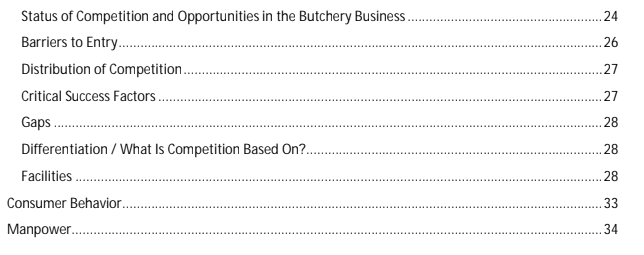Beef Butchery Business Plan
Beef Butchery Business Plan


Overview
Before we get to what is happening at the local level here are some quick figures giving a statistical overview of butchery business:
̧ Kenyans consume an average of 16kg of red meat per individual annually.
̧ Nairobi has the highest average consumption of meat per individual at 25.8 kg per person annually.
̧ Nairobi and Mombasa are estimated to consume 17% of the meat in Kenya
̧ An average of 2000 carcasses are consumed in Nairobi every day.
̧ An average of 70,000 sheep and goats are slaughtered in Nairobi every day.
̧ In Mombasa the average annual consumption per individual is 21 kilograms.
̧ An average of 8000 cattle and about 20,000 goats and sheep are slaughtered in Mombasa every month.
̧ Kenya consumes an average of 600,000 Metric tonnes of red meat per year.
̧ The beef market in Kenya is concentrated in urban areas. This is due to a high
concentration of consumers with disposable income and also the urban lifestyle which promotes the consumption of beef.
̧ About 2 % of red meat consumed in Kenya comes from specialist ranches
̧ Between 2006 and 2012 meat consumption in Kenya increased by 41%.
̧ Keeping all factors constant consumption is expected to continue rising. The biggest threat to the increase in beef consumption is a high inflation and a shrinking economy. Beef Butchery Business guide
̧ On average, households in Nairobi spend 29% of their total expenditure on food. The proportion of money spent on food is higher among the low income groups than the higher income groups.
̧ A consumer survey indicated that over 90% of households purchased their fruits and vegetables from two or fewer outlets, about 80 % used the same number for meat. For staple foods (sugar, maize flour, tea leaves etc) though only 30 % used a regular retailer.
̧ Overall, households in Nairobi spend 15% of their basic food budget on vegetables,
8%on fruit, and 3% on Irish and sweet potato. In comparison, they spend 18% on dairy Products, 14% on beef, 12% on wheat products, and 11% on maize products
̧ Middle class in this survey is as defined by Kenya National Bureau of Statistics as those earning between Kshs.23, 670 and Kshs.199, 999 per month. We hasten to add in this case too middle class is not just about the money but social exposure and lifestyle. Rural consumers who fall into the above definition of middle class tend to be conservative in their consumption compared to those in urban areas.
̧ Though there are dissenting views about the size and definition of the middle class a reliable static from the AfDB estimates 6.5 million Kenyans are among this middle class and the number is expanding.
̧ Kenya’s inflation rate peaked in September 2013 from August’s’ 6.47 to 8.97 before reducing slightly to 8.25 in October. It is important to note that inflation does not affect all economic and social classes the same. In October for instance the inflation rate among the middle class was 6.32 compared to a national average of 8.25.
Download Beef Butchery Business Plan / guide here